Commentary 20 Nov 2009 08:53 am
Tezuka on DVD
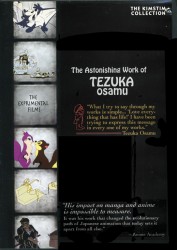 - Kino Video has an excellent DVD available of the work of Osamu Tezuka. Called The Astonishing Work of Osamu Tezuka, the disc covers a wide range of this truly experimental filmmaker’s films.
- Kino Video has an excellent DVD available of the work of Osamu Tezuka. Called The Astonishing Work of Osamu Tezuka, the disc covers a wide range of this truly experimental filmmaker’s films.
He was probably most famous for the Manga he created which became Astro Boy. The creator of the big-eyed cartoon character, he’s often credited as the father of Anime. This video contains none of that work.
What it does include, is a number of shorts – 15, to be exact, – which are always interesting, sometimes peculiar, and in a couple of cases great.
For me two films stand out: Jumping and Broken Down Film.
Jumping is a tour-de-force of animation. The camera acts as the eyes of a jumper, bouncing up and down and through an animated landscape. As the camera bounds up and down, higher and lower, more and more violently, everything animates in a wide perspective. It ends the way it starts; after the complete evolution and destruction of society, it returns to the beginning. The film is brilliantly animated by Junji Kobayashi.
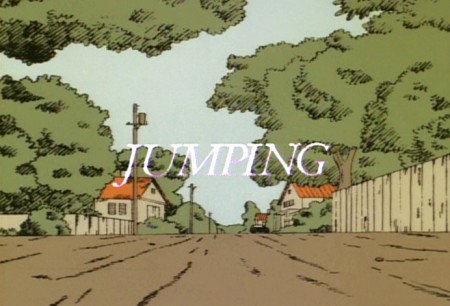
(Click any image to enlarge.)
Jumping (1984) is on YouTube, but the transfer is bad. Low Res and out of sync. It’s an excellent film, but this version becomes annoying quickly.
Broken Down Film is an exercise in recreating a horrible film experience – watching an old film that falls apart before our eyes. However, as if it were a Tex Avery cartoon, the dirty, scratchy print affects the characters as well.
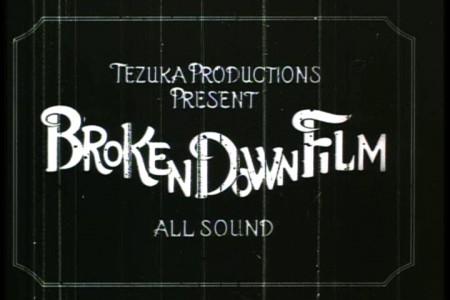
Right from the title, we are treated to violent scratches in the film.
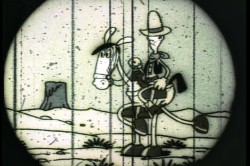 2
2 3
3
A cowboy on his horse has to deal with the jumping film gate.
He corrects it by pushing the frame back in place.
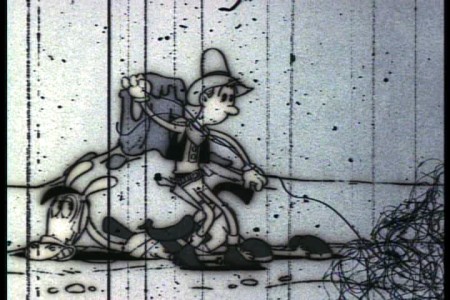 4
4
However, then there’s the lint at the bottom right.
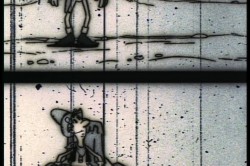 5
5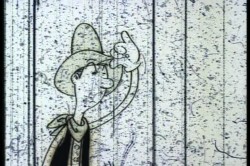 6
6
The film jumps again, but
he hears a damsel in distress.
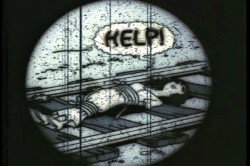 7
7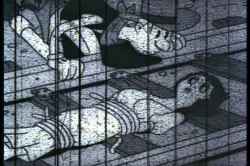 8
8
He moves in to help the girl but there’s too much snow.
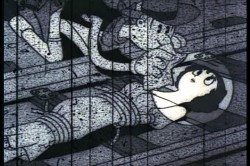 9
9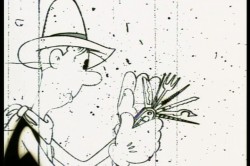 10
10
He wipes some away and pulls out his swiss army knife.
to cut the rope that binds her.
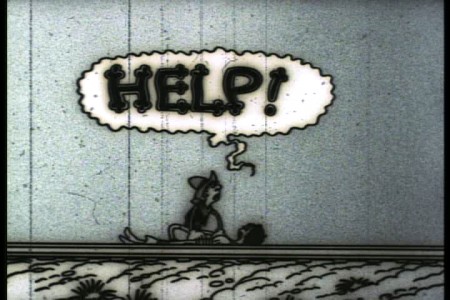 12
12
He takes the “Help” balloon . . .
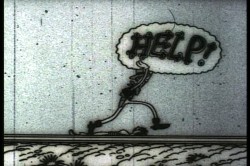 13
13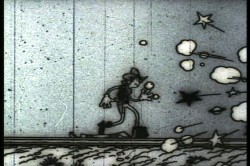 14
14
. . . and throws it in front of the train.
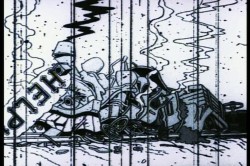 15
15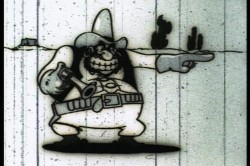 16
16
After taking care of an oncoming train,
there’s the villain shooting at him.
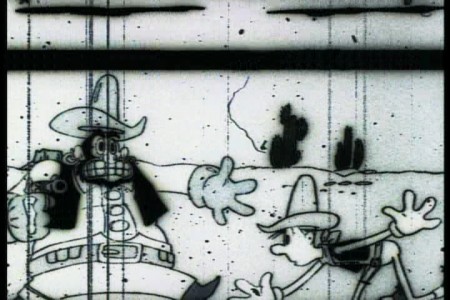
The jumping frame knocks them both off their centers.
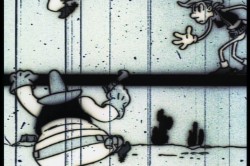 18
18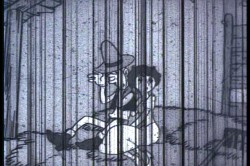 19
19
Good guy traps the villain in the film frame
and goes back to the girl in the scratched frame.
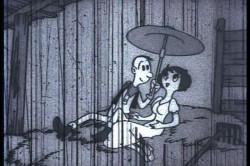 20
20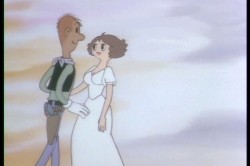 21
21
He truns his hat into an umbrella to clear the raining scratches,
and the image turns into a color musical.
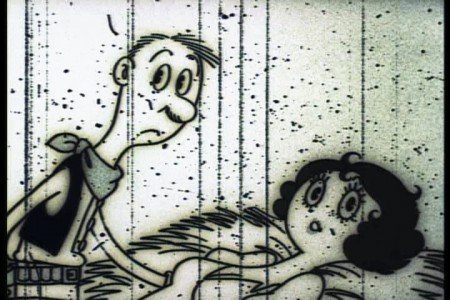 23
23
Until it suddenly goes back to B&W.
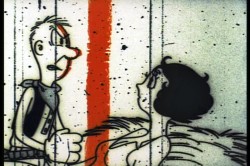 24
24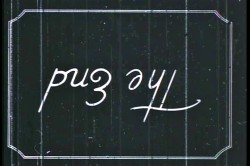 25
25
They can’t even kiss. The china marker comes off
on his face. Annoyed, but the image splits to the End credit.
Broken Down Film (1985) on YouTube. It’s not a bad version.
The DVD is expectedly, excellent quality. It also includes a lengthy interview with Tezuka who goes through each of his films. His films are quirky, but I’m glad to have them in my collection.
- Miyazaki has a brief chapter about Tezuka in his book, Starting Point: 1979-1996. He does not have very positive things to say about the older director, Tezuka.
- I found myself disgusted by the cheap pessimism of works like Ningyo (Mermaid), or Shizuku (The Drop), which showed a drop of water falling on a thirsty man adrift at sea. I felt that this pessimism was qualitatively different from the pessimism Tezuka used to have in the old days, as in the early days of Atom (Astro Boy), for example—but it also could have been that in the early days I felt great tragedy and trembled with excitement at Tezuka’s cheap pessimism precisely because I was so young.
And later in the essay he continues:
- From a senior of mine in the industry, I once heard that when Tezuka was working on the production of the Saiyuki (Alakazam the Great) animation feature, he reportedly advocated inserting an episode showing the hero monkey, Songoku, coming back and finding his girlfriend (also a monkey) dead. But there was never any reason for the girl monkey to be dead. When I learned from other people that Tezuka had advocated this simply because “it would be more moving,” I fully realized that I could part ways with him.
Finally, he concludes this essay:
- The end of the Showa period
(Dec 25 1926- Jan 7 1989 – The era of Emperor Hirohito)
Overall, my opinion of Tezuka is as follows: I appreciate him for being the person to pioneer story manga, and for having created the current of the times in which we work today. So when writing or speaking about him in public, I have always referred to him with respect as “Osamu Tezuka.” And this is because he was not just my rival, but also my predecessor. I have written about him exactly the same way I would write about some other famous historical figure from the past, like Hirobumi Ito. And I think I am correct to appreciate him in this way.
In terms of animation, however, I think I have the right and responsibility to say the following—everything that Mr. Tezuka talked about or emphasized was wrong.
Why did such an unfortunate state of affairs arise? I think, as can be seen from Tezuka’s early manga works, it is because his starting point was Disney. Because in Japan at the time there was no one who could be his teacher, no one he could emulate, Tezuka’s early works are almost all just imitations of Disney. To them he merely added his own narrative element. I say added, but his worlds continued to be created under huge influence from Disney. As a result, he always had an inferiority complex, a fear that he would never be able to surpass “the grand old man.” That’s why he always thought that he had to outdo Disney’s Fantasia, or Pinoc-chio, and why he was never able to overcome his compulsion to do so. At least that is my interpretation. It becomes understandable if you think of his work in animation as a hobby—something a rich man might do for a diversion.
When I heard that Tezuka had passed away, I truly felt that it was the end of the Showa era, even more so than when I heard that the Showa Emperor himself had passed away. Tezuka was a ferociously active person, and in his life he probably accomplished three times more than most people do. So given that he died at sixty, he really lived a hundred and eighty years’ worth. I think that he truly lived a full life.
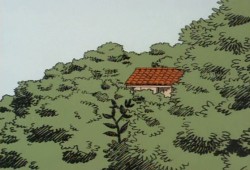
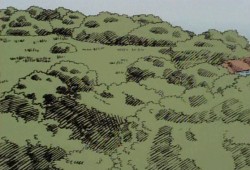
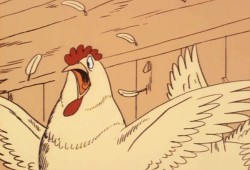

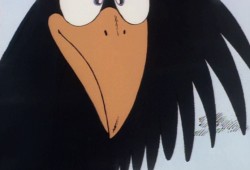



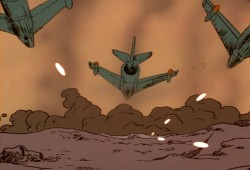
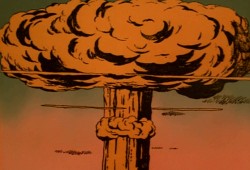
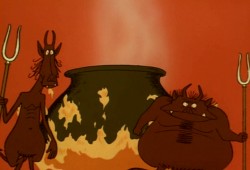
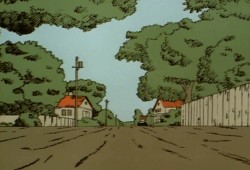
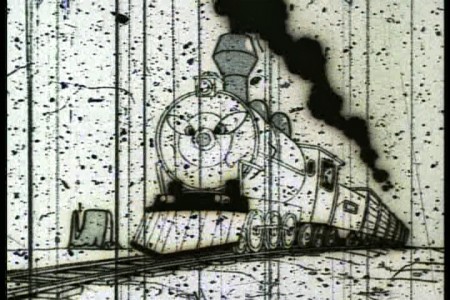
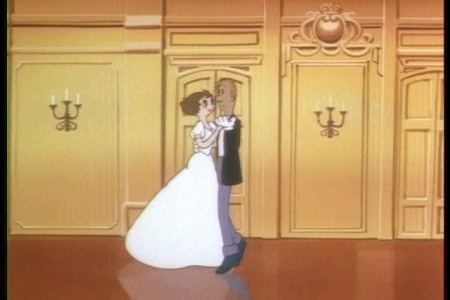

on 20 Nov 2009 at 9:59 am 1.Jeff Defalque said …
Here’s a better web version of “Jumping”:
http://www.dailymotion.com/video/xezlk_jumping-tezuka
on 20 Nov 2009 at 10:01 am 2.Elliot Cowan said …
“In terms of animation…everything that Mr. Tezuka talked about or emphasized was wrong.”
Quite a definitive statement!
on 20 Nov 2009 at 5:39 pm 3.Jenny said …
Quotes like Miyazaki’s on Tezuka here always get me wondering: what sort of personal history colors them-how much and what kind of water went under the bridge that I’ll never be privy to?
And I’m confused-apparently In Miyazaki’s opinion Tezuka erred by trying too hard to emulate Disney, yet on the other hand he indulged in pessimism?
And what is “cheap pessimism”? I’d guess it to mean a view not arrived at honestly…but isn’t that projecting the observer’s impression(Miyazaki)onto whatever thoughts or feelings the artist might have held? At any rate it seems harsh.
I’m far from an expert on Tezuka-in fact I’m quuite ignorant of the man’s work except in bits from TV, mostly “Kimba”-but ewhen I was about 8 years old one afternoon viewing of Alakazam really riveted and afterward haunted me…it seemed unusually poignant and soulful(no pun intended), all american translations and “funny animal characters” aside.
on 20 Nov 2009 at 5:55 pm 4.Michael said …
It’s actually my fault for not posting the entire essay by Miyazaki. He goes into more depth about what he calls Tezuka’s pessimism.
However, I think, even more, he dislikes what Tezuka did on Astro Boy when he did the half-hour shows for such a low budget (500,000 yen – which is today about $5000), thus forever lowering budgets for Japanese TV fare.
on 20 Nov 2009 at 6:41 pm 5.Pierre Fontaine said …
Gee, if you ever read any interviews with Mr. Miyazaki, he’s about the most pessimistic person that ever lived. He’s pessimistic about the environment, about human-kind, about the animation industry itself. What’s funny is that this pessimism isn’t reflected in his animated work where the human spirit wins out all the time. Perhaps Mr. Miyazaki’s work are a kind of wish fulfillment for his own troubled mind.
I can’t say I’m all that aware of pessimism in Tezuka’s cartoons though. He certainly seemed adept at introducing pathos into his shows however. In Astro Boy’s opening episode, a scientist’s has a son, the son is killed in a car accident. The scientist tries to recreate the boy as a robot and ultimately rejects him (which is amazingly like the movie A.I).
In Kimba, his father is shot, and Kimba and his mother are placed in a cage and put on a boat. The mother tosses Kimba overboard and he has to struggle to swim to shore, all the while seeing a vision of his mother in the sky giving him divine guidance. This mixture of pathos and entertainment had a huge impact on me as a young boy watching these shows in the 1960′s.
I agree that Miyazaki’s comments seem harsh. His animated work, especially the films meant for children, have a very small touch of pathos but are more clinical in their approach to storytelling. Still, I certainly can’t fault Tezuka for his approach to storytelling, which I see as quite distinct from the Disney influence that Miyazaki ascribes to Tezuka.
on 21 Nov 2009 at 1:00 pm 6.pavlovich said …
“Mermaid” is my favorite short by Tezuka although “Jumping” is certainly up there too. I love his experimental films, 13 of which came out on a disc called “Tezuka The Experimental Films” (In Australia) obviously similar to the disc posted above.
While I have loved many of Miyazaki’s films and believe that he is one of the best animation feature film directors from Japan, I disagree with his negative views of Tezuka’s work.
And now that Disney have their financial ties to Ghibli Studio should he be airing the view that the influence of that studio on one of the most revered animators in Japan as a bad thing?
Yet, a man that can give me a film like “Ponyo” is still always worth listening to on the subject of animation, so while disagreeing, I still respect his point of view, and I am looking forward to reading “Starting Point”.
on 22 Nov 2009 at 10:31 pm 7.Joshua Smith said …
I also wonder if Miyazaki’s criticisms of Tezuka stem more from the perceived negative consequences he had on the animation industry. The two were artists of different generations, and for the most part, different mediums. Miyazaki’s first job in animation was as an inbetweener on Wan Wan Chushingura (1963), the last of three Toei features based on a Tezuka story (a good anime trivia question since this is the only project that ever had the involvement of both artists). But by that point, Tezuka had little involvement with the Toei feature since he was busy making TV anime at his own studio. Just as Miyazaki was starting to find his voice in the realm of full feature animation, Tezuka had already undermined that business by showing that cheap TV animation was more profitable. Of course, that was inevitable. If it hadn’t been Astro Boy, it would have been something else.
on 25 Nov 2009 at 7:28 am 8.Eddie W said …
I agree with Pavlovich. “Mermaid” is most of the most beautifully, simple, emotive and beautiful short animations I have ever seen. So glad this dvd compilation is allowing more people to see Tezuka’s lesser known works.
on 26 Nov 2009 at 11:51 pm 9.daniel thomas macinnes said …
I do agree with Michael that you need to read Miyazaki’s essay in its entirety to really understand what he was trying to say. His essay caused a bit of controversy in Japan, as Tezuka was an institution. Indeed, there’s something of the rebellious upstart in Miyazaki’s words, and I’m reminded of great, revolutionary anime of his youth – Horus, Prince of the Sun, and Heidi, Girl of the Alps.
I also believe it is critical to read Miyazaki’s memoirs, Starting Point. Westerners really don’t have an idea who the man really is, how his worldview evolved, or his approach to his medium. He is simply crammed into the Walt Disney mold, and that’s that.
on 27 Nov 2009 at 5:15 am 10.Steve Brown said …
Even after growing up on Astro Boy and Kimba, and later becoming acquainted with Tezuka’s features and experimental short films, I was still blown away after seeing a retrospective exhibition of his production drawings and mangas in Tokyo last year. Tezuka’s productivity was amazing, as was his facility for writing and for creating memorable characters. It was also interesting seeing production art from his “adult” (i.e. sexually oriented) features. This seems to be an aspect of his work which is not so well known in the west. At any rate, a master is a master, even when he is not your particular “cup of tea”.